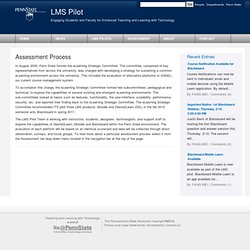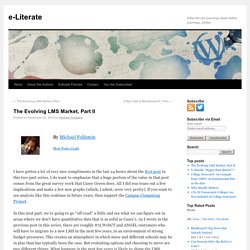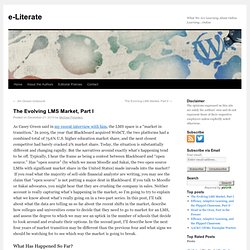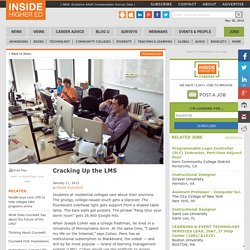

Assessment Process - LMS Pilot. In August 2009, Penn State formed the eLearning Strategic Committee.

The committee, comprised of key representatives from across the university, was charged with developing a strategy for sustaining a common eLearning environment across the university. This included the evaluation of alternative platforms to ANGEL, our current course management system. To accomplish this charge, the eLearning Strategic Committee formed two subcommittees, pedagogical and technical, to explore the capabilities of several existing and emergent eLearning environments. The sub-committees looked at topics such as features, functionality, the user-interface, scalability, performance, security, etc. and reported their finding back to the eLearning Strategic Committee.
The eLearning Strategic Committee recommended ITS pilot three LMS products: Moodle and Desire2Learn (D2L) in the fall 2010 semester and, Blackboard in spring 2011. - e-Literate. I have gotten a lot of very nice compliments in the last 24 hours about the first post in this two-part series.

I do want to emphasize that a huge portion of the value in that post comes from the great survey work that Casey Green does. All I did was tease out a few implications and make a few new graphs (which, I admit, were very pretty). If you want to see analysis like this continue in future years, then support the Campus Computing Project. In this next part, we’re going to go “off-road” a little and see what we can figure out in areas where we don’t have quantitative data that is as solid as Casey’s. As I wrote in the previous post in this series, there are roughly 875 WebCT and ANGEL customers who will have to migrate to a new LMS in the next few years, in an environment of strong budget pressures.
Let’s see if we can read the tea leaves. More on Market Share Numbers Actually, they can. At any rate, we have about as good a picture of the recent past as we’re likely to get. - e-Literate. As Casey Green said in my recent interview with him, the LMS space is a “market in transition.”

In 2005, the year that Blackboard acquired WebCT, the two platforms had a combined total of 75.6% U.S. higher education market share, and the next closest competitor had barely cracked 2% market share. Today, the situation is substantially different and changing rapidly.
Iversity. Instructure. Coursekit. What LMS do you prefer? Have you tried this one? What does the LMS of the future look like? Students at residential colleges care about their environs.

The grungy, college-issued couch gets a slipcover. The fluorescent overhead light gets support from a shaded table lamp. The bare walls get posters. The phrase “Feng Shui your dorm room” gets 26,900 Google hits. When Joseph Cohen was a college freshman, he lived in a University of Pennsylvania dorm. There was only one problem. A year earlier, on the other side of the country, a pair of graduate students at Brigham Young University — Brian Whitmer and Devlin Daley — had been wondering the same thing. “Coursekit and us — the beginning story is very similar,” says Whitmer, who at the time was working toward a master’s degree in human-computer interaction. Both the BYU duo and Cohen arrived at the same solution. In the spring of 2008, Whitmer and Daley took a class in software entrepreneurship. In some ways, the companies are fundamentally different: Instructure markets to administrators in addition to individual instructors.